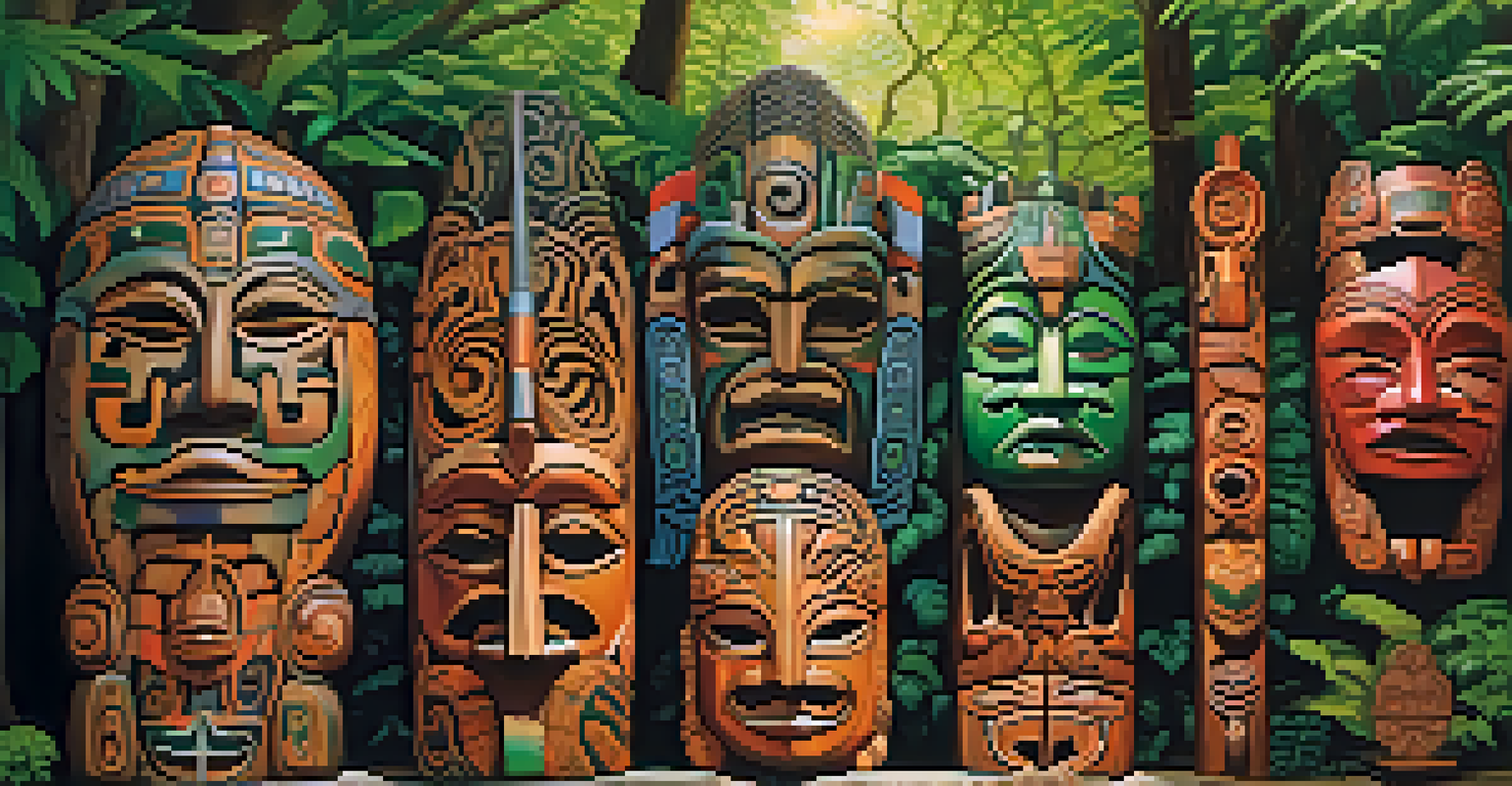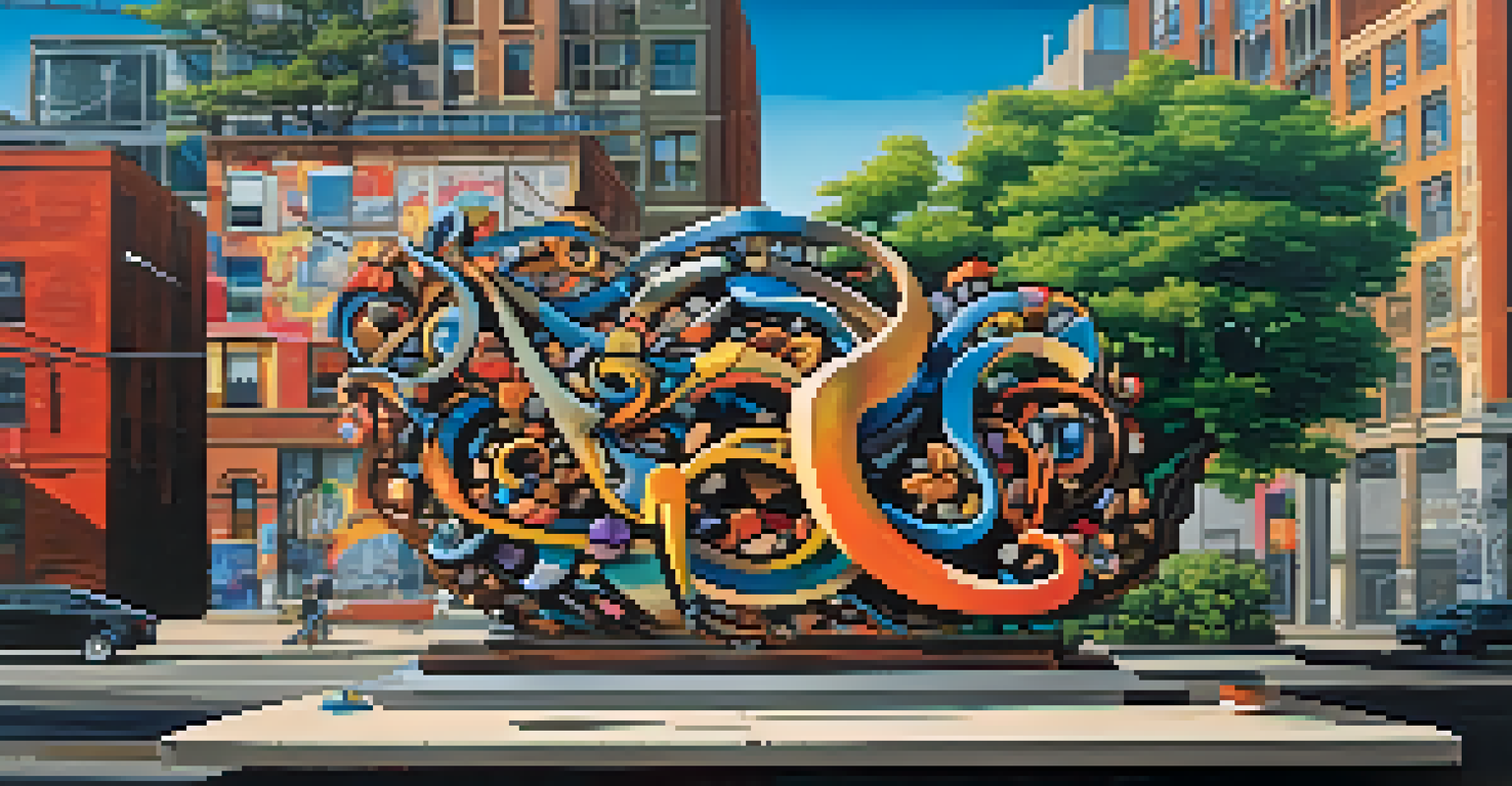Carving as Cultural Expression: A Global Perspective

The Roots of Carving: A Historical Overview
Carving dates back thousands of years, serving as one of humanity's earliest forms of artistic expression. From ancient civilizations to modern societies, carving has been a means to communicate beliefs, values, and stories. For instance, the intricate stone carvings of the Egyptians not only adorned their temples but also represented their gods and the afterlife.
Art is the most beautiful of all lies; it allows us to express the inexpressible.
As we delve into different cultures, we see that carving materials vary widely, from wood and stone to bone and ivory. Each medium carries its own significance; for example, wood carving in the Pacific Islands often reflects the natural surroundings and spiritual beliefs of the community. Thus, the choice of material is not merely practical but deeply cultural.
Over time, carving has evolved, influenced by technological advancements and globalization. Yet, despite these changes, the fundamental purpose of carving as a means of cultural expression remains steadfast, showcasing the enduring human need to create and connect.
Symbolism in Carving: Language Beyond Words
One of the most fascinating aspects of carving is its ability to convey complex ideas and emotions without uttering a single word. Different cultures imbue their carvings with symbolic meanings that can be understood by those within the community. For instance, the Maori carvings of New Zealand often depict ancestral stories, serving as both art and historical record.

The use of symbols in carving extends beyond mere decoration; it often serves a functional purpose in rituals and ceremonies. In many Indigenous cultures, carved totems are not only artistic expressions but also represent the tribe's lineage and spiritual beliefs. This duality of function and meaning enriches the cultural significance of the art.
Carving: A Timeless Cultural Art
Carving has been a vital form of artistic expression throughout history, reflecting diverse cultural beliefs and practices.
As we explore various global traditions, it becomes evident that carving serves as a universal language, bridging gaps between generations and communities. These symbols carry stories, preserving the past while inviting future interpretations.
Regional Variations: Carving Techniques Around the World
Carving techniques can vary significantly from one region to another, shaped by local materials, traditions, and cultural influences. For example, Japanese woodblock printing, known as Ukiyo-e, combines carving with printmaking to produce stunning artworks that reflect the transient beauty of life. This technique highlights not only craftsmanship but also a distinct aesthetic philosophy.
The greatest art is not what is seen, but what is felt.
In contrast, African mask carving showcases intricate designs that serve ceremonial purposes, embodying the spirit of the ancestors and acting as a medium for communication. Each region’s unique approach to carving reveals how environmental factors and societal needs influence artistic expression.
These regional variations in carving techniques not only highlight the diversity of cultural practices but also celebrate the shared human experience of creativity. By understanding these differences, we gain insight into the rich tapestry of global artistic traditions.
Carving in Contemporary Art: A Modern Perspective
In the contemporary art scene, carving continues to thrive, with artists pushing the boundaries of traditional techniques. Many modern sculptors experiment with new materials and forms, blending age-old practices with innovative ideas. This fusion creates a dialogue between the past and the present, offering fresh interpretations of cultural identities.
For instance, artists like El Anatsui use discarded materials to create large-scale installations that challenge conventional notions of carving and sculpture. This approach not only addresses issues of sustainability but also reflects the artist's heritage and commentary on consumerism, demonstrating how carving can evolve while maintaining cultural significance.
Symbolism Connects Generations
Carving serves as a universal language, conveying complex ideas and emotions that preserve cultural narratives across generations.
As carving finds its place in contemporary art, it invites a broader audience to engage with cultural narratives. This accessibility fosters appreciation for the diverse ways in which carving can express identity, history, and social commentary.
Carving as a Community Activity: Traditions and Teaching
Carving is often a communal activity, passed down through generations, where knowledge and skills are shared among community members. In many cultures, this practice fosters a sense of belonging and identity, as apprentices learn not only the techniques but also the spiritual significance behind their craft. For example, in Indigenous cultures, carving workshops often serve as a rite of passage for young members.
These community gatherings not only strengthen bonds but also ensure the preservation of cultural heritage. Through storytelling and shared experiences, older generations impart wisdom and values, reinforcing the connection between past and present. This intergenerational exchange enriches the carving tradition and keeps it alive.
As global interest in traditional crafts grows, many communities are embracing this opportunity to teach carving to a wider audience. Workshops and cultural festivals celebrate this art form, inviting people from different backgrounds to learn and appreciate the cultural significance behind each carved piece.
Challenges Facing Carving Traditions: A Global Outlook
Despite its rich history, carving traditions face various challenges in today's rapidly changing world. Globalization, while promoting cultural exchange, can also lead to the commercialization of traditional crafts, risking the authenticity and significance of the art. Many artisans struggle to balance between maintaining their cultural integrity and meeting market demands.
Additionally, environmental concerns pose a threat to carving practices, particularly in regions where deforestation affects the availability of traditional materials. As artisans rely on specific wood types or stone, the depletion of these resources raises questions about sustainability and the future of carving traditions.
Challenges and Future of Carving
Despite facing challenges like globalization and environmental concerns, carving traditions are evolving through innovation and community engagement.
Addressing these challenges requires a collective effort from artisans, communities, and consumers. By supporting ethical practices, valuing cultural narratives, and promoting sustainable materials, we can help ensure that carving remains a vibrant form of cultural expression for generations to come.
The Future of Carving: Reviving and Innovating Traditions
Looking ahead, the future of carving is filled with potential for revival and innovation. As younger generations become interested in their cultural heritage, there has been a resurgence in traditional carving techniques. This renewed interest not only safeguards these practices but also encourages experimentation and adaptation to contemporary contexts.
Moreover, technology plays a significant role in shaping the future of carving. Digital tools and techniques, such as 3D modeling and CNC machines, are being incorporated into traditional practices, allowing artists to explore new dimensions and possibilities. This fusion of old and new can create exciting pathways for expression, appealing to a wider audience.

Ultimately, the evolution of carving will be defined by how communities embrace their heritage while navigating modern challenges. By fostering creativity, promoting collaboration, and respecting traditions, carving can continue to be a powerful form of cultural expression in an ever-changing world.